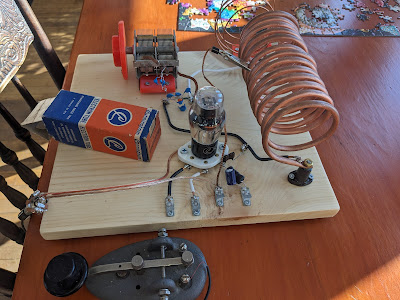Building and Operating a Transmitter from the Roaring 20s

Radio was booming in the 1920s: transmitters had started using the pure tone of 'continuous wave' signals, replacing signals sent with sparks, and increasingly selective and sensitive receiver circuits offered greater range seemingly by the month. Amateurs, not yet able to tame their simple transmitters with crystal-controlled oscillators, constructed them on simple wooden boards with heavy wiring and large inductor coils in order to keep heating from causing their signals to drift. These homebrew transmitters were ongoing experiments in electronics and engineering. The position of a coil might increase output power but cause the signal to sound like a buzzsaw. If you could find a higher voltage power supply, that too would raise its power, but the increased currents in the rig would add more drift: if the other guy can't find your signal wandering up and down the band, what use is that extra 3 watts? The 1929 QSO Party Every year the Antique Wireless Association holds a tw



